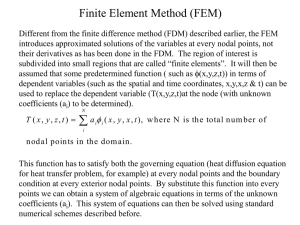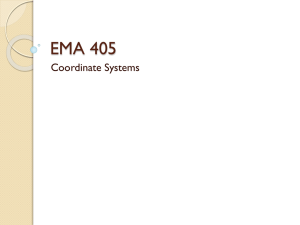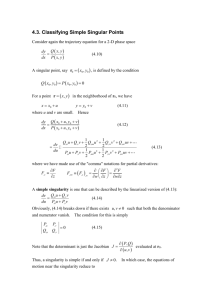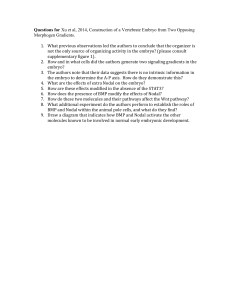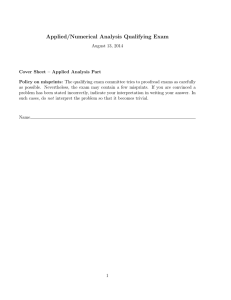Steps in Differential Geometry, Proceedings of the Colloquium
advertisement
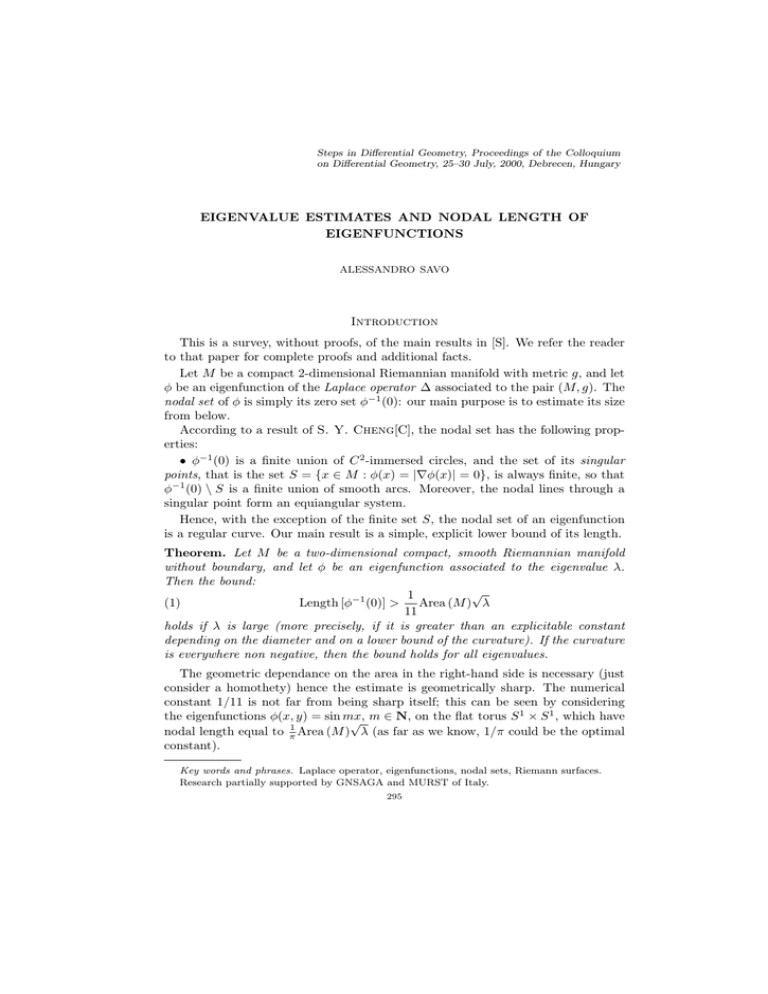
Steps in Differential Geometry, Proceedings of the Colloquium
on Differential Geometry, 25–30 July, 2000, Debrecen, Hungary
EIGENVALUE ESTIMATES AND NODAL LENGTH OF
EIGENFUNCTIONS
ALESSANDRO SAVO
Introduction
This is a survey, without proofs, of the main results in [S]. We refer the reader
to that paper for complete proofs and additional facts.
Let M be a compact 2-dimensional Riemannian manifold with metric g, and let
φ be an eigenfunction of the Laplace operator ∆ associated to the pair (M, g). The
nodal set of φ is simply its zero set φ−1 (0): our main purpose is to estimate its size
from below.
According to a result of S. Y. Cheng[C], the nodal set has the following properties:
• φ−1 (0) is a finite union of C 2 -immersed circles, and the set of its singular
points, that is the set S = {x ∈ M : φ(x) = |∇φ(x)| = 0}, is always finite, so that
φ−1 (0) \ S is a finite union of smooth arcs. Moreover, the nodal lines through a
singular point form an equiangular system.
Hence, with the exception of the finite set S, the nodal set of an eigenfunction
is a regular curve. Our main result is a simple, explicit lower bound of its length.
Theorem. Let M be a two-dimensional compact, smooth Riemannian manifold
without boundary, and let φ be an eigenfunction associated to the eigenvalue λ.
Then the bound:
√
1
(1)
Length [φ−1 (0)] >
Area (M ) λ
11
holds if λ is large (more precisely, if it is greater than an explicitable constant
depending on the diameter and on a lower bound of the curvature). If the curvature
is everywhere non negative, then the bound holds for all eigenvalues.
The geometric dependance on the area in the right-hand side is necessary (just
consider a homothety) hence the estimate is geometrically sharp. The numerical
constant 1/11 is not far from being sharp itself; this can be seen by considering
1
1
the eigenfunctions φ(x, y) = sin mx,
√ m ∈ N, on the flat torus S × S , which have
1
nodal length equal to π Area (M ) λ (as far as we know, 1/π could be the optimal
constant).
Key words and phrases. Laplace operator, eigenfunctions, nodal sets, Riemann surfaces.
Research partially supported by GNSAGA and MURST of Italy.
295
296
ALESSANDRO SAVO
For the generalization to manifolds with boundary, we refer to [S].
Let us now give a short history of the problem. In 1972, Brüning and Gromes
[B-Gr] proved that, if Ω is an open domain in the Euclidean plane, and φ is an
eigenfunction associated to the eigenvalue λ (for the Dirichlet boundary condition)
then
1
Area (Ω) √
πj(k − 1)
√
Length [φ−1 (0) ∩ Ω] + Length (∂Ω) ≥
λ−
,
2
2j
2 λ
where j is the first zero of the Bessel function J0 , and k is the number of holes
of Ω. Note that if λ is large enough then, for the interior nodal length, one has a
lower bound of the type:
√
(2)
Length [φ−1 (0) ∩ Ω] ≥ c0 Area (Ω) λ.
where c0 is a numerical constant. Later, Brüning proved in [B] that, if M is a
compact 2-manifold without boundary, then, for large eigenvalues λ:
√
(3)
Length [φ−1 (0)] ≥ C1 λ,
with C1 now depending on the curvature and the injectivity radius of M .
Our result is a generalization to manifolds of Brüning-Gromes’ Euclidean bound
(2); in particular, it implies that the constant C1 in (3) can be taken to be independent of the curvature.
In arbitrary dimension, the nodal set φ−1 (0) of an eigenfunction φ is almost a
regular hypersurface, in the sense that the singular set S has codimension at least
2. If Vol n−1 denotes, by a slight abuse of language, Hausdorff (n−1)−dimensional
measure, then Yau conjectured that
√
√
(4)
C1 λ ≤ Vol n−1 [φ−1 (0)] ≤ C2 λ
for constants C1 and C2 depending only on M .In their remarkable work [D-F],
Donnelly and Feffermann proved the conjecture for analytic
√ manifolds and for
large eigenvalues; in other words, the ratio Vol n−1 [φ−1 (0)]/ λ does not go to 0 or
∞ as the eigenvalue tends to infinity. However, no explicit expression of C1 and
C2 is given.
Our method does not extend, at least immediately, to higher dimensions. So,
we wonder if inequalilty (1) extends to the arbitrary dimension n: in other words,
does there exist a numerical constant c0 such that
√
Vol n−1 [φ−1 (0)] ≥ c0 Vol n (M ) λ,
when λ is sufficiently large (or, for all λ under some curvature assumptions)?
The main theorem.
The main bound (1) in the introduction is a corollary of Theorem 1 below. Fix
the eigenfunction φ on the Riemann surface M associated to the eigenvalue λ. Let
p be a point on the nodal set of φ, and define ν(p), its order, to be the number of
EIGENVALUE ESTIMATES AND NODAL LENGTH OF EIGENFUNCTIONS
297
nodal lines through p (so that p is singular iff ν(p) ≥ 2; note that ν(p) is also the
order of vanishing of φ at p). Denote by
X
(5)
|S| =
(ν(p) − 1)
p∈S
the total number of singular points (counted with their “multiplicities”). Then
|S| ≥ 0, and |S| = 0 iff the nodal set of φ is smooth.
We assume that the Gaussian curvature K of M is bounded below
by −α2 , with
q
α ≥ 0; we let K − = min{K, 0}, D = Diam (M ), c(α, D) =
q
2
2
ψ(λ, α, D) = min{c(α, D), π 2 + α c(α,D)
}.
4λ
π 2 + 14 α2 D2 and
Theorem 1. Let M be a compact oriented Riemann surface without boundary,
and φ an eigenfunction associated to the eigenvalue λ. Then:
√
4Area (M )
Length [φ−1 (0)] ≥
λ
4π + π 2 ψ(λ, α, D)
Z
1
πψ(λ, α, D)
−
2π|S| −
|K | ·
.
·
1+
2Area (M )
λ
M
The bound (1) now follows because limλ→∞ ψ(λ, α, D) = π, |S| ≥ 0 and
4
4π+π 3
>
1
11 .
Corollary 2. If the curvature of M is everywhere non-negative then, for all eigen√
(M )
λ. Furthermore,
functions φ one has: Length [φ−1 (0)] ≥ 4Area
4π+π 3
(6)
Length [φ−1 (0)] ≥
2
Area (M )
4 + π 2 Diam (M )
Note that (6) follows combining the first bound with the estimate of [L-Y]:
π2
λ1 (M ) ≥ 4D
2 , thus giving a purely geometric estimate (it is interesting only for
low eigenvalues, in particular the first).
Finally, a few remarks on the singularity set S, which is of independent geometric
interest. The following estimate of its cardinality |S| is due to Dong [Do]:
Z
1
1
|K − |.
(7)
|S| ≤
Area (M ) +
4π
2π M
Using Dong’s estimate, and the proof of Theorem 1, one also has:
Z
√
1
1
−1
(8)
|S| ≤ Length [φ (0)] λ +
|K − |.
2π M
4
Dong also gives an estimate of the number of singular points inside a small disk.
Similar estimates were given in [D-F2]; these estimate are then used to establish
upper bounds for the nodal length.
Note finally that |S| also counts (with multiplicity) the number of critical points
of the eigenfunction which lie on the nodal set. It would be desirable to have a
bound for the whole critical set of an eigenfunction.
298
ALESSANDRO SAVO
An eigenvalue estimate, and the outline of the proof
We first observe that, if φ is an eigenfunction on the manifold M associated to
the eigenvalue λ, and if Ω is a nodal domain of φ (that is, a connected component
of M \ φ−1 (0)), then
(9)
λ = λ1 (Ω)
where λ1 (Ω) is the first eigenvalue of Ω for the Dirichlet boundary conditions.
The strategy in the proof of Theorem 1 is to give an upper bound of λ1 (Ω) by
the square of the boundary volume, and then sum over all nodal domains. If Ω is
a simply connected (or doubly connected) domain in the Euclidean plane, such an
upper bound is due to Polya [P]:
(10)
λ1 (Ω) ≤
π 2 Length (∂Ω)2
,
4 Area (Ω)2
We re-write (10) as:
p
π
Area (Ω) λ1 (Ω) ≤ Length (∂Ω).
2
In particular, if φ is an eigenfunction on the flat torus, such that all of its nodal
domains are simply connected, or doubly connected, we obtain immediately the
(sharp) bound:
√
1
(12)
Length [φ−1 (0)] ≥ Area (M ) λ
π
simply by summing (11) over all nodal domains of φ. However, the above condition
on the the nodal domains may not be met; moreover, we want to consider arbitrary
curved manifolds.
So the first step is to generalize Polya’s bound to an arbitrary 2-manifold with
boundary; this is accomplished by the following Proposition, which is valid in
arbitrary dimensions:
(11)
Proposition 3. Let Ω be a domain with piecewise-smooth boundary in an arbitrary
manifold M . If λ1 (Ω) denotes the first eigenvalue of Ω for the Dirichlet boundary
conditions, then:
π2
Vol n−1 (∂Ω)2
,
C(Ω)2
4
Vol n (Ω)2
n
o
−1
where C(Ω) = sup Vol n−1 [ρ (r)] .
Vol n−1 (∂Ω)
r
(13)
λ1 (Ω) ≤
Here ρ denotes the distance function from the boundary of Ω, so that ρ−1 (r) is
the family of interior parallels, that is, the hypersurfaces of Ω at constant distance
r from the boundary (note that the interior parallels are not in general regular, so
by Vol n−1 [ρ−1 (r)] we really mean the volume of their regular part).
In general, the constant C(Ω) can be upper bounded in terms of a lower bound
of the mean curvature of ∂Ω and a lower bound of the Ricci curvature of Ω (see
EIGENVALUE ESTIMATES AND NODAL LENGTH OF EIGENFUNCTIONS
299
[S]). In some cases, however, the volume of the interior parallels is a non-increasing
function of the distance r from the boundary (so that C(Ω) = 1); this happens for
example when both the mean curvature of ∂Ω and the Ricci curvature of the domain
are non-negative (or when Ω ⊆ R2 is simply connected, or doubly connected, the
situation considered by Polya), and one has in these cases:
λ1 (Ω) ≤
π 2 Vol n−1 (∂Ω)2
.
4 Vol n (Ω)2
An upper bound of λ1 (Ω) in dimension 2. Proposition 3 takes an interesting
form in dimension 2; in that case, the constant C(Ω) can be upper bounded by the
integrals of the curvatures of the domain (rather then the pointwise bounds of the
curvatures needed in higher dimensions). This is an important fact in deriving the
nodal length estimates we are looking for. In fact, for the length of the interior
parallels one can prove the following inequality, valid for all r:
Z
(14)
Length [ρ−1 (r)] ≤ Length (∂Ω) + R(Ω) max{ K + − 2πχ(Ω), 0}.
Ω
where R(Ω) is the inner radius of Ω (that is, the radius of the largest disk which
fits into Ω), and K + is the positive part of the Gaussian curvature. (This bound is
rather delicate, and extends the validity of the corresponding bound due to Fiala
and Hartmann in special cases (see [Fi], [H])). Eventually one proves
Proposition 4. Let Ω be a domain with piecewise-smooth boundary in an oriented
Riemann surface M . Then:
Z
p
π Length (∂Ω) π R(Ω)
λ1 (Ω) ≤
+
max{ K + − 2πχ(Ω), 0}.
2 Area (Ω)
2 Area (Ω)
Ω
The main steps of the proof of Theorem 1. Fix the eigenfunction φ on
our 2-manifold M , associated to the eigenvalue λ, and consider the family {Ωi }i∈I
of all nodal domains of φ: then λ1 (Ωi ) = λ for all i (note that I is a finite index
by Courant’s nodal domain theorem).
Step 1. Apply Proposition 4 to Ωi and get, for all i ∈ I:
√
(15)
2Area (Ωi ) λ ≤ πLength (∂Ωi ) + πR(Ωi ) max{B(Ωi ), 0}.
R
where B(Ωi ) = Ωi K + − 2πχ(Ωi ), K + = max{K, 0} denotes the positive part of
the Gaussian curvature K of M , and R(Ωi ) is the inner radius of Ωi .
Step 2. Estimate the inner radius of each nodal domain:
√
(16)
R(Ωi ) ≤ ψ(λ, α, D)/ λ
where ψ(λ, α, D) has been defined in Theorem 1 (we use here the domain monotonicity of the first eigenvalue, and Cheng’s comparison
√ theorem). Note that, since
ψ(λ, α, D) → π as λ → ∞, the nodal set becomes π/ λ−dense in M , as λ → ∞.
300
ALESSANDRO SAVO
Step 3. Sum (15) over all i ∈ I, keeping in mind that summing the boundary
lengths of all nodal domains gives twice the nodal length:
√
π ψ(λ, α, D) X
√
B(Ωi ).
(17)
Area (M ) λ ≤ πLength [φ−1 (0)] +
2
λ
i∈I−
where I− = {i ∈ I : B(Ωi ) > 0}.
Step 4. Show that:
√
Z
X
π λ
(18)
B(Ωi ) ≤
Length [φ−1 (0)] +
|K − | − 2π|S|.
2
M
i∈I−
Taking into account (17) and (18) we get Theorem 1.
Few words about inequality (18). First observe that
Z
X
(19)
B(Ωi ) =
|K − | − 2π|S|
M
i∈I
P
which follows from the addition formula i∈I χ(Ωi ) = χ(M ) + |S| and the GaussBonnet theorem. Hence:
Z
X
X
(20)
B(Ωi ) =
|B(Ωi )| +
|K − | − 2π|S|
i∈I−
i∈I+
M
the main point is now to show (see Lemma 11 in [S]) that if i ∈ I+ then:
λ
π√
(21)
|B(Ωi )| ≤ Area (Ωi ) ≤
λLength (∂Ωi )
2
4
and (18) follows by summing (21) over i ∈ I+ . Note that, when M is a flat torus,
(21) reads 2π ≤ λ2 Area (Ωi ) which is essentially the Faber-Krahn inequality applied
to Ωi .
References
[B]
J. Brüning, Über knoten eigenfunktionen des Laplace-Beltrami operators, Math. Z. 158,
(1978), 15–21.
[B-Gr] J. Brüning and D. Gromes, Über die Länge der Knotenlinien schwingender Membranen,
Math. Z. 124, (1972), 79-82.
[C]
S. Y. Cheng, Eigenfunctions and nodal sets, Comm. Math. Helv. 51, (1976), 43–55.
[C2]
S. Y. Cheng, Eigenvalue comparison theorems and its geometric applications, Math. Z.
143, (1975), 289–297.
[Do]
R.T. Dong, Nodal sets of eigenfunctions on Riemann surfaces, J. Diff. Geom. 36, (1992),
493–506.
[D-F] H. Donnelly and C. Fefferman, Nodal sets of eigenfunctions on Riemannian manifolds,
Inv. Math. 93, (1988), 161–183.
[D-F2] H. Donnelly and C. Fefferman, Nodal sets for eigenfunctions of the Laplacian on surfaces,
J. Amer. Math. Soc. 3, (1990), no. 2, 333–353.
[Fi]
F. Fiala, Le problemes des isoperimetres sur les surfaces ouvertes a courbure positive,
Comm. Math. Helv. 13, (1941), 293-346.
[Ga]
S. Gallot, Inégalités isopérimétriques et analitiques sur les variétés riemanniennes,
Astérisque 163–164, (1988), 31–91.
EIGENVALUE ESTIMATES AND NODAL LENGTH OF EIGENFUNCTIONS
301
[H]
P. Hartman, Geodesic parallel coordinates in the large, Amer. J. Math. 86, (1964), 705–
727.
[He-K] E. Heintze and H. Karcher, A general comparison theorem with applications to volume
estimates for submanifolds, Ann. Sc. Ecole Norm. Sup. 11, (1978), 451–470.
[Her] J. Hersch, The method of interior parallels applied to vibrating membranes, Studies of
Mathematical Analysis and related topics, Univ. Calif. Press, Stanford, Calif. 1962.
[L-Y] P. Li and S. T. Yau, Estimates of eigenvalues of a compact Riemannian manifold, Proc.
Symp. Pure Math. Vol 36, (1980), 205–239.
[Os]
R. Osserman, A note on Hayman’s theorem on the bass note of a drum, Comm. Math.
Helv. 52, (1977), 545–555.
[P]
G. Polya, Two more inequalities between physical and geometric quantities, Jour. Indian
Math. Soc. 24, (1960), 413–419.
[S]
A. Savo, Lower bounds for the nodal length of eigenfunctions of the Laplacian, Annals of
Global Analysis and Geometry 19, (2001), 133–151.
Dipartimento di Metodi e Modelli Matematici, Università di Roma, La Sapienza, Via
Antonio Scarpa 16, 00161 Roma
E-mail address: savo@dmmm.uniroma1.it

